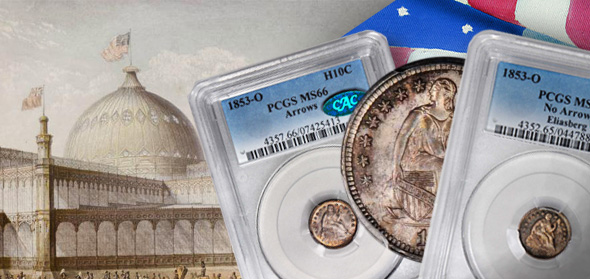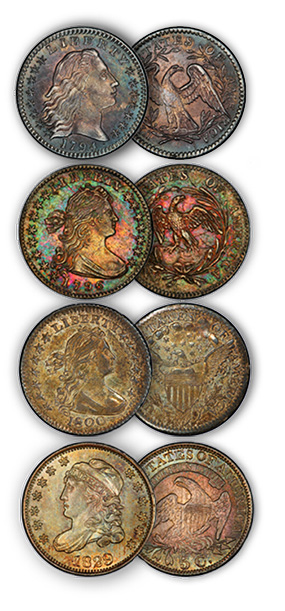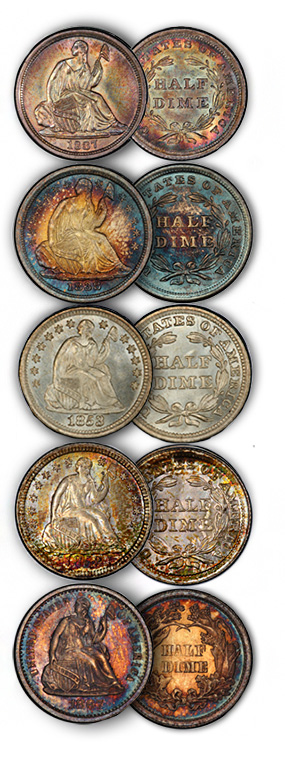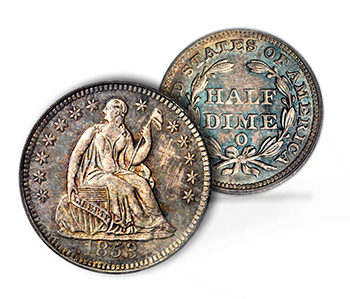News and Analysis regarding scarce coins, coin markets, and the coin collecting community #250
A Weekly CoinWeek Column by Greg Reynolds …..

There were eight, gem quality, business strike 1853 Liberty Seated half dimes (5¢ silver coins) in two recent coin auctions, four from each of two collector-consignors. Stack’s-Bowers sold the “1853 Collection” on Oct. 30 in Baltimore and Heritage auctioned a vast selection of coins from the Gardner Collection on Oct. 27 in New York. These half dimes are very scarce or rare in all grades, and gem pieces are important condition rarities. It is astonishing that such a selection of gem quality 1853 half dimes of all issues was sold in four days, or even in a whole year!
The special historical importance of U.S. silver coins dated 1853 was addressed in two recent articles, the first on the 1853-O ‘No Arrows’ Liberty Seated half dollar and the second on the ‘1853 Collection’ MS-66 Liberty Seated silver dollar. It would not make sense to repeat historical details here, as the importance of the coinage act of 1853 and bimetallism are discussed in those articles. It could be logically argued, though, that U.S. silver coins minted in 1853 have greater historical significance than U.S. silver coins made in the 1840s or later in the 1850s.
What are Half Dimes?
Most U.S. citizens tend to think of U.S. five cent coins as “nickels.” Actually, nickel is not the largest component of a five cent nickel, in a metallurgical sense. Nickels are traditionally 25% nickel and 75% copper. Five cent nickels were introduced in 1866. Three cent nickels date from 1865 to 1889 and thus pre-date five cent nickels. Long before the metal ‘nickel’ was first used in U.S. coinage in 1857 Flying Eagle cents, silver five cent coins called half dimes were minted.
I maintain that 1792 half dismes are patterns and constitute a separate topic.
U.S. Half Dimes were first struck in 1794, though dimes were not produced until 1796. Half dimes weigh half as much as corresponding dimes, and contain half as much silver.
 There are nine design types of half dimes: 1) Flowing Hair (1794-95); 2) Draped Bust, Small Eagle (1796-97); 3) Draped Bust, Heraldic Eagle (1800-05); 4) Capped Bust (1829-37); 5) Liberty Seated, No Stars (1837-38); 6) Liberty Seated, With Stars, No Drapery (1838-40); 7) Liberty Seated, With Stars, With Drapery, No Arrows (1840-1859, except 1854-55); 8) Liberty Seated, With Arrows (1853-55); 9) Liberty Seated, Legend on Obverse (front) – 1860-73.
There are nine design types of half dimes: 1) Flowing Hair (1794-95); 2) Draped Bust, Small Eagle (1796-97); 3) Draped Bust, Heraldic Eagle (1800-05); 4) Capped Bust (1829-37); 5) Liberty Seated, No Stars (1837-38); 6) Liberty Seated, With Stars, No Drapery (1838-40); 7) Liberty Seated, With Stars, With Drapery, No Arrows (1840-1859, except 1854-55); 8) Liberty Seated, With Arrows (1853-55); 9) Liberty Seated, Legend on Obverse (front) – 1860-73.
The obverse is the front of a coin. Half dimes were not struck after 1873. In 1853, arrows were added because the specified weight of each half dime was reduced from 20.625 grains (about .0430 Troy ounce) to 19.2 grains (exactly 0.04 Troy ounce). Therefore, type #7, ‘With Stars and No Arrows,’ is dividable into two historically significant groups, as the half dimes struck from 1840 to 1853 are heavier than those ‘With Stars, No Arrows’ Liberty Seated half dimes that were struck from 1856 to 1859.
Half dimes in the first group, and even earlier half dimes, for the most part, stopped circulating around 1850 because each contained more than five cents worth of silver bullion. From 1850 to 1853, U.S. silver coins tended to be melted, exported or traded as bullion, especially by the owners of businesses that amassed quantities of silver coins.
After arrows were added in 1853, each half dime struck contained less than five cents worth of silver bullion. In 1853, half dimes without arrows were issued early in the year and mintage of ‘with arrows’ half dimes probably started in March.
Two arrows were added, one at either side of the numerals of the year ‘1853,’ to indicate the reduction in weight so that people would then know that those half dimes ‘with arrows’ each contained less than five cents worth of silver. There was no longer a motive to trade half dimes as bullion.
 Logically, half dimes, dimes, quarters and half dollars dating from 1856 to 1859 should have featured arrows as well. In response to my inquiry, leading researcher R. W. Julian noted that he has “not yet read in detail all the letters” in the U.S. Mint archives from the mid-1850s.
Logically, half dimes, dimes, quarters and half dollars dating from 1856 to 1859 should have featured arrows as well. In response to my inquiry, leading researcher R. W. Julian noted that he has “not yet read in detail all the letters” in the U.S. Mint archives from the mid-1850s.
Even so, Bob Julian agrees to “tentatively” comment, “The use of arrows was purely arbitrary and by the end of 1855 Mint officials had decided that they were no longer needed. It is likely that Director Snowden simply decided that the arrows had been there long enough.” Perhaps by late 1855, almost all U.S. citizens had come to accept that the face values of then currently produced silver coins (except silver dollars) were higher than their respective silver bullion values, so there was a motive to spend U.S. silver coins as money.
My guess is that the adopted design concepts for Liberty Seated silver coins, in use in 1852, did not allow for additional design elements to be comfortably placed near the numerals. The addition of arrows may have thus made some such silver coins more difficult to produce and/or tended to cause other design elements to not be struck as well, on average. The metal used to form arrows would otherwise have been available for the formation of other devices (raised structures on the coin). Could it be true that U.S. Mint officials figured that coins were more appealing and/or were easier to produce without arrows on the obverse?
The ‘No Arrows’ 1853 half dimes were probably struck in Jan. and Feb. 1853. R. W. Julian indicates that “No Arrows half dimes could have been legally struck until May 31, 1853, but this is highly unlikely. In Philadelphia, production of ‘with arrows’ coins began in March. Once the new law, which was passed on Feb. 21, became known to New Orleans Mint officials, silver coinage on the new standard probably began as soon as was practical,” Julian maintains.
1853 ‘No Arrows’ – Philadelphia Mint
 The “1853 Collection” contained a PCGS graded and CAC approved, MS-65, 1853 ‘No Arrows’ Liberty Seated half dime. By tradition, coins that grade 65 or higher are termed ‘gems.’ This is a great coin, with a grade that may reach the MS-66 range.
The “1853 Collection” contained a PCGS graded and CAC approved, MS-65, 1853 ‘No Arrows’ Liberty Seated half dime. By tradition, coins that grade 65 or higher are termed ‘gems.’ This is a great coin, with a grade that may reach the MS-66 range.
There is much original luster beneath mottled toning. The russet-gray tones are especially pleasant.
The PCGS holder indicates that this half dime was formerly owned by Louis Eliasberg, who formed the all-time greatest collection of U.S. coins. It does seem to match the pictures in the Eliasberg ’96 catalogue. Bowers & Merena (New Hampshire) auctioned Eliasberg’s half dimes in New York in May 1996.
This coin sold for $2585, a strong price, in the retail range, though probably worth at least that much to buyers who understand this coin. This is a really pleasing half dime that scores high in the category of originality and has a great pedigree.
A Gene Gardner pedigree is great too. Indeed, it is probably true that Gardner formed the all-time best collection of 19th century, U.S. silver coins that has ever been publicly offered. Nevertheless, the Gardner 1853 ‘No Arrows’ half dime that sold on Oct. 27 was overgraded. It is PCGS graded “MS-68“ and is not exciting. A true ‘68’ grade silver coin is spectacular or extremely beautiful, in addition to being nearly flawless.
The Gardner piece brought $12,825, which is a strong price for a MS-67 grade coin. Nonetheless, it is the only 1853 ‘No Arrows’ half dime that is certified as grading “MS-68.” If relevant bidders really thought that this coin merited its assigned MS-68 grade, it would have realized much more than $12,925, at least $17,000, maybe as much as $35,000! The PCGS price guide value of “$22,500” would be a low retail price for a true MS-68 grade 1853 ‘No Arrows’ half dime. One might not exist.
1853-O ‘No Arrows’ – New Orleans Mint
 Liberty Seated half dimes without arrows, of the pre-1853 weight standard, were minted in New Orleans as well as in Philadelphia during early 1853. Both the “1853 Collection” and the Gene Gardner Collection contained excellent representatives of the 1853-O ‘No Arrows’ issue. Curiously, each is PCGS graded MS-65 and CAC approved
Liberty Seated half dimes without arrows, of the pre-1853 weight standard, were minted in New Orleans as well as in Philadelphia during early 1853. Both the “1853 Collection” and the Gene Gardner Collection contained excellent representatives of the 1853-O ‘No Arrows’ issue. Curiously, each is PCGS graded MS-65 and CAC approved
These are the only two that are PCGS graded MS-65 and they were auctioned three days apart. The “1853 Collection” coin was also previously in the Eliasberg Collection, like the just mentioned “1853 Collection” Philadelphia Mint ‘No Arrows’ half dime.
This O-Mint piece has even, natural toning, mostly tan and brown-russet on the obverse (front). The reverse has some nice green hues in the inner fields. There are light abrasions here and there.
Although I very much like both the Gardner and Eliasberg-“1853 Collection” O-Mint ‘No Arrows’ half dimes, the Gardner piece is a little better. The grade of the Eliasberg piece is easily in the middle of the 65 range, almost in the high end. The Gardner piece is of higher quality, at least 65 ‘high end’!
The Eliasberg-“1853 Collection” coin realized $25,850 and the Gardner coin brought $32,900. These are moderate to strong prices and are consistent with the slight difference in quality between the two. In general, market prices for these have dropped in 2014. The Gardner piece is likely to be the finest currently known and the Eliasberg coin is close behind.
1853 ‘With Arrows’
The “1853 Collection” With Arrows half dime is PCGS graded MS-67 and CAC approved. Although this is a wonderful original coin, I was a little surprised to see a CAC sticker. I figured its grade in the high end of the 66 range. Nonetheless, others may place its grade solidly in the middle of the 67 range. Certainly, it scores highly in both the originality and technical categories; there are hardly any abrasions and the few that are there are barely noticeable.
A Gardner 1853 ‘With Arrows’ half dime is NGC graded MS-67. It is a very attractive coin, though it has nowhere near the eye appeal that most relevant experts would expect of a 67 grade coin. Moreover, there are some medium hairlines in the obverse inner fields that are hard to notice, as they are obscured by some stuff, which could be natural. In any event, this coin’s grade is not close to MS-67.
There is another 1853 ‘With Arrows’ half dime in the Gene Gardner Collection, which will be auctioned in 2015. That piece is PCGS graded MS-66 and CAC approved. It may be of higher quality than the Gardner 1853 ‘With Arrows’ half dime that sold on Oct. 27.
The “1853 Collection” MS-67 coin brought $18,800, a strong price. This Gardner “MS-67” coin brought $5728.13, which is too high a price, given its true quality.
1853-O ‘With Arrows’
The “1853 Collection’ New Orleans Mint ‘With Arrows’ half dime is PCGS graded and CAC approved MS-66. My grade for this coin is solidly in the middle of the 66 range and I am not alone. No one suggested otherwise, as far as I know.
After being lightly dipped decades ago this coin has naturally retoned in a nice way, with much luster and soothing orange-russet hues. Further, it scores highly in the technical category, a very likable coin. This “1853 Collection” coin went for $7637.50, a strong price, which was a little above than the value range I would have expected the auction result to fall within.
The Gene Gardner 1853-O ‘With Arrows’ that sold on Oct. 27 is PCGS graded MS-67 and CAC approved. Yet, it brought just $16,450. A retail price for a MS-67 grade 1853-O ‘WA’ half dime would be from $22,500 to $28,500. One possibility is that it brought a not strong price because it just does not have the eye appeal that most relevant experts would associate with a 67 grade. In my view, a solid 67 grade coin must be stunning, or wonderful in other ways. This is a great, MS-66-plus grade 1853-O.
The Gardner Collection is known for containing many duplicates. Some collectors sell their duplicates and others keep them. It seems that Gene kept many or all of them.
Two other Gardner Collection 1853-O ‘With Arrows’ half dimes will be auctioned in 2015, one is NGC graded MS-61. The other is PCGS graded MS-66 and CAC approved.
Proof? 1853 ‘With Arrows’
The “1853 Collection” contained an 1853 ‘With Arrows’ half dime that was certified by NGC as a “Proof,” though non-gradable because of a severe cleaning. This coin has more problems than just having been subjected to an “improper cleaning’! Furthermore, its claimed Proof status is highly questionable. If many relevant bidders really thought that this coin is a Proof, it probably would have realized a price that was much higher than the $4993.75 result. If it is not a Proof, than this result would be extremely high. I really would need more time to try to make sense of this coin, which I would not recommend.
If any exist, Proof 1853 half dimes are extraordinarily rare. PCGS has certified one as “Proof-64,” which might be the same as the coin that was earlier NGC certified as “Proof-64.” I cannot draw a conclusion from the images on PCGS CoinFacts. In many cases, there is a need to examine a coin in actuality to determine whether it is a Proof. If this PCGS certified piece is a Proof, it may be a restrike that is characterized by many ‘strike-throughs’ other than those traced to lint. These unusual strike-throughs are often found on silver Proofs that were struck from 1857 to 1859.
There were no 1853 half dimes, of any type or variety, catalogued as Proofs in the pertinent auctions of the Norweb, Eliasberg, Starr and Pittman Collections, respectively. In the Norweb I sale, there was a Proof 1854 half dime, which was pedigreed to the Elliott Landau Collection that the firm of New Netherlands auctioned in 1958.
One deceased researcher was under the impression that Landau had a Proof 1853. Could he or someone else have mistakenly referred to Landau’s Proof 1854 as an 1853 half dime? A typo or data entry error at some point along the way, or just a mental mix-up, could have lead to confusion regarding Landau’s half dimes. Also, there is not a Proof 1853 half dime listed in the HA online archives.
During “more than fifty years” as a collector and coin professional, Richard Burdick has spent considerable time researching and analyzing pre-1860 Proof coins. Richard recounts that he was “a student of John Pittman and Lester Merkin.” Furthermore, Burdick has inspected dozens of pre-1860 Proof coins and advised people who collect them. Moreover, he attended “all but three ANA Conventions since 1969” and most major coin auctions, plus “dozens of other events.” Richard declares that “never once has he seen an 1853 half dime, of any variety, that comes close to being a Proof.”
© 2014 Greg Reynolds




